#star trek: discovery final episode
Text
Reblog your grievances, I’m VERY interested to hear your thoughts & viewpoints.
Finally: Do NOT hold back. Let it rip.
#fandom#worst of the worst#worst#awful#public opinion#fans#movies#comic books#TV#television#DC#Marvel#Transformers#Final Fantasy#Pokémon#Star Trek#Star Wars#Steven Universe#Adventure Time#Five Nights At Freddy’s#Sonic The Hedgehog#Halo#Halo Paramount#Star Wars Episode VIII: The Last Jedi#Pokémon: Black And White#Star Trek: Discovery#Transformers IDW#She-Hulk: Attorney At Law#CW Batwoman#Sonic Boom
21 notes
·
View notes
Text
Star Trek Discovery highlighting Black Men's mental health
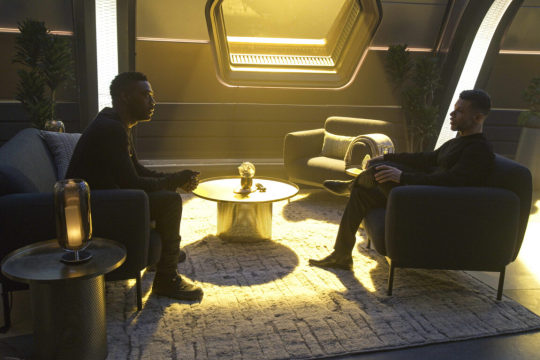
I know DSC prioritizes their female representation, and as a woman, I do appreciate it. But these scenes in season 4 episode 4, All is Possible, with Book and Dr. Culbert are powerful.
1. Seeing a Black man tending to his mental health reflects the current conversation in our community about destigmatizing mental health, especially for Black men. In an article I found about Black men and mental health the author wrote:
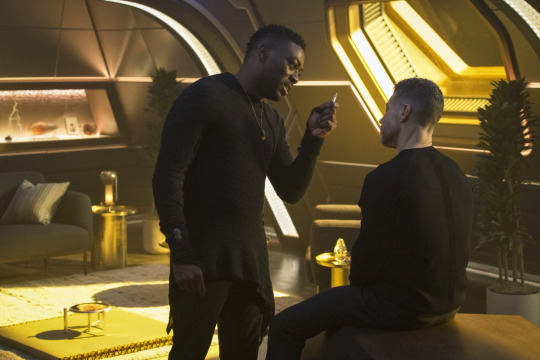
"Black men face a unique challenge in that most of what is most prized about them may be their looks or bodies, but rarely ever their intellect and emotional intelligence. These things are often deemed too soft for any Black man to experience, delivering the message that if you are those things then you must change…and fast." The author continues later on:
"In most instances, Black men have not grown up believing that their internal emotional lives have inherent and productive value. This needs to change." Source:
Season 4 of DSC allows Book, a Black (Kwejian) man, to matter beyond his physical attributes and sex appeal (b/c David Ajala is fine!). The audience is provided an opportunity to go on an emotional journey from a Black man's perspective and ties his mental health to the overall story and plot of season 4, which gives both inherent and productive value to his emotional and mental state.

Yes, this is important because the lives and mental health of Black men matter beyond issues like police brutality. IMHO, this is an instance of DSC doing a good job of addressing current social issues and incorporating aspects of Black culture that aren't as universally recongized.
Another aspect that's shown in this episode is Book having access to resources that help him with his mental health. This shows the benefit of people having easy (or easier) access to this form of health care.
2. Seeing a Latino man in a professional position with power and influence is uncommon on TV in the US. Being the ship's therapist is not an easy job, but Dr. Culbert manages it with grace and genuine care. He's one of my favorite characters on show.
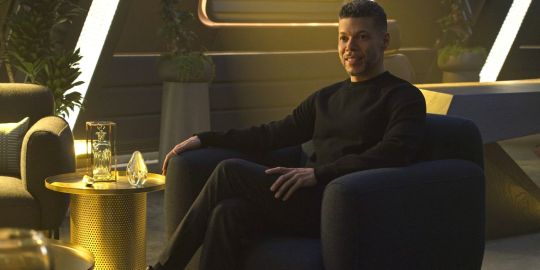
3. I loved seeing a Black man and a Latino man helping each other - and it not be about racism. I also liked seeing Dr. Culbert talk about his Puerto Rican culture as a way to connect with Book regarding Book's Kwejian culture... Now don't get me wrong, I do believe conversations about racism amongst minority groups should happen. I just think it's good that we show people of color having conversations that are centered around other issues.
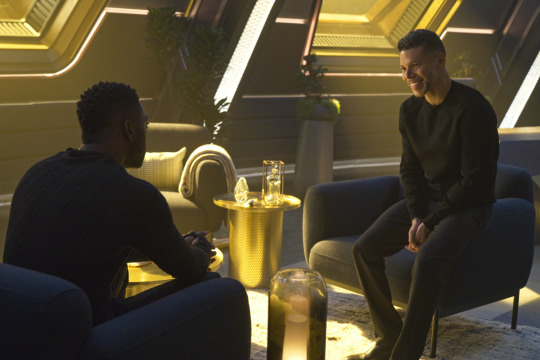
I hope this made sense. It's something I really loved in this recent season of DSC and I didn't see that much conversation about it. So I wanted to throw my perspective out here.
🖖🏿
#i've had this post sitting in my drafts for a WHILE#glad I finally posted it#mental health#black men#cleveland booker#dr hugh culber#star trek discovery#season 4 episode 4#my perspective#star trek#star trek dsc#dsc
24 notes
·
View notes
Text
This is one of the greatest things ever. Walk around every single version of the U.S.S. Enterprise in photorealistic 3D in your browser, from the Roddenberry Archive. On a phone you just see wraparound 3D pics. On a PC or laptop you get the full 3D interactive experience. They NEED to make this VR compatible, it'll be beyond words.
There are more Enterprises here than Tumblr will allow me photos of, and more will likely be added.
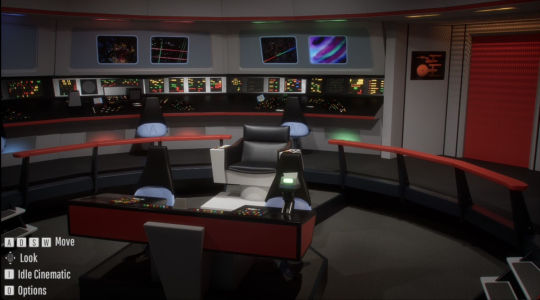
Here's the TOS Enterprise, which appears in several incarnations ("The Cage", "Where No Man Has Gone Before" and TOS proper as well as TAS with the second turbolift!), has the correct original graphics and is perfect.

This is the bridge from the unmade Star Trek: Phase II series (whose pilot episode "In Thy Image" was rewritten to become Star Trek: The Motion Picture), with it's legendary big comfy command sofa seat and tactical display bubble!
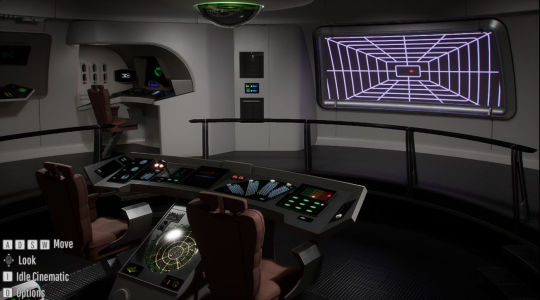
The Motion Picture, such an accurate recreation that there's even a very faint flicker on the rear-projection animated screens as seen in the movie.
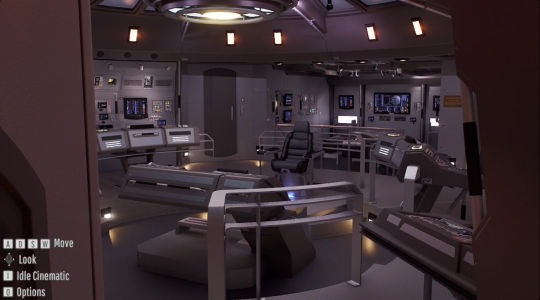
Enterprise NX-01, looking exactly as it did in "Broken Bow"
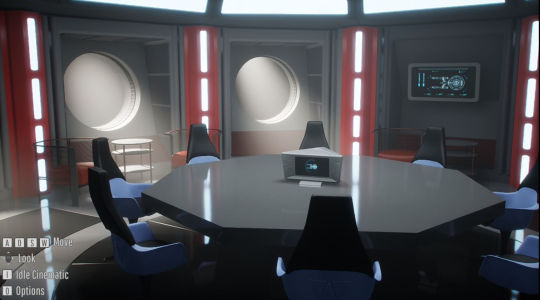
Recognise this? It's the briefing room of Discovery season 2's version of the U.S.S. Enterprise NCC-1701. Although at the front of the saucer on the "real" ship, here it's off the second bridge door which may well be where the set was IRL.
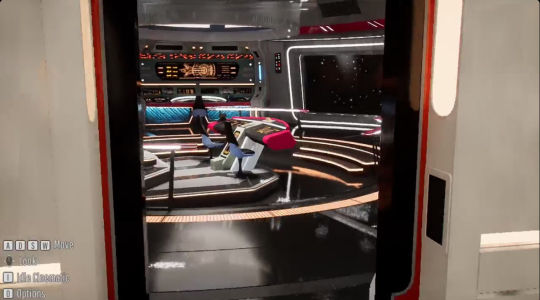
I wasn't expecting modern Trek to be represented equally as the originals in this project, but it is. This is the Enterprise from Strange New Worlds, with Pike's Ready Room located just off the bridge.

Star Trek V: The Final Frontier. My favourite version of the classic bridge, as a kid I drew all these control panels and stuck them on my bedroom walls. And now I can look around and look at them all close-up! They've even replicated the noticable TVs stuffed into the panels for the more complex animated screens.
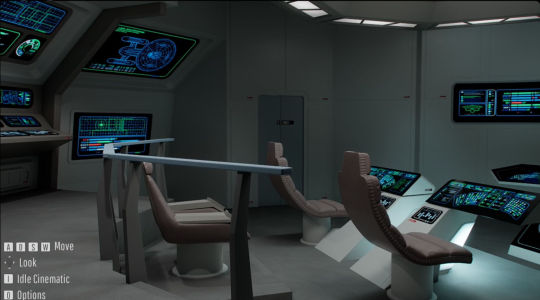
The Enterprise-C bridge from "Yesterday's Enterprise". This one has always fascinated me, being a low-budget TV set (formerly the Enterprise-D battle bridge, originally built from the rain-damaged TMP set's back wall and redressed endlessly though TNG) representing TNG's immediate predecessor. In the episode they mostly shoot the back wall and imply the consoles make a huge circle, but here you can see the set's real dimensions and the weirdness of the classic movie helm/nav console in front of the TNG con/ops panels. I love it.
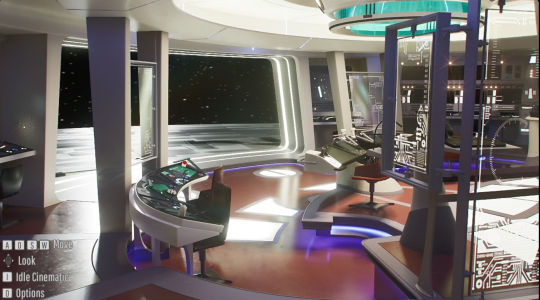
You know how much I love the Kelvin movies, so seeing this was amazing. For some reason the consoles don't have their screens lit (hopefully this'll be fixed soon), but you can see the saucer under the window and it's shiny and amazing.
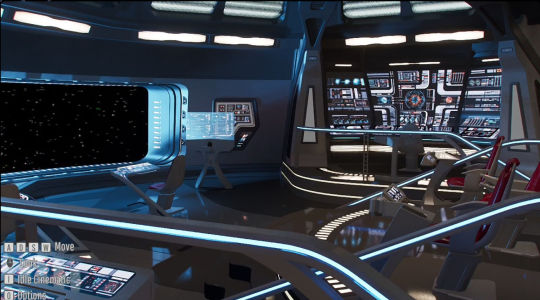
The last thing I expected was the U.S.S. Titan-A/Enterprise-G bridge, but it's here. And the lights are on.
Other bridges available to explore which I'm out of pictures to show: The Enterprise-D (of course), Enterprise XCV-330 (the ringship, based on concept art for the unmade non-Trek series "Starship"), the Planet of the Titans U.S.S. Enterprise (again, based on concept art for a cool multi-levelled set) and the "launch" U.S.S. Enterprise NCC-1701 (based on the very first piece of TOS bridge set concept art), the Enterprise-E, the Enterprise-F (seen on viewscreen for all of 2 minutes in Picard) and the U.S.S. Voyager NCC-74656!
Take a bow lads, you've done good. Now just add VR support!
That link again.
#star trek#star trek aos#star trek movies#tng#voyager#star trek picard#star trek phase 2#roddenberry archive#strange new worlds#set design#deep lore#star trek ships#star trek tech#star trek discovery#star trek enterprise#enterprise#uss enterprise#ncc 1701#starfleet museum
6K notes
·
View notes
Text
Star Trek theme tunes: worst to best
Star Trek’s many TV series each have an opening sequence that attempts to set up the viewer for the show ahead. A good theme tune delivers a high-quality piece of music that encapsulates the show’s essence — and it is on this basis that I’ve ranked the themes. What isn’t included in my ranking is anything about the graphics that accompany the music, nor the show itself. Naturally, these are all purely my personal opinions, so there can be no argument.
Let’s get started!
11: Enterprise
“It’s been a long road…” are five words that launched a lot of strong feelings — and rightly so. The jarring mismatch between everything about this song and everything Enterprise was about relegates this theme to the bottom of the heap. The opening graphics are spot-on for the show’s premise — but I never got to watch them because I needed to skip the music, and that makes me madder.
If you want to know what could have been, search YouTube for “Star Trek: Enterprise Opening Credits with Archer’s Theme”. That music is perfect for the show: slow, dramatic, building up for the big reveal. Then finish weeping / gnashing your teeth and come back here.
This theme also meant that we can never have a Star Trek theme with words again, ever, because we have been all primed to hate such things because of Enterprise — and that’s sad.
Imagine if we’d had a good theme with words that we could all sing at appropriate and inappropriate occasions.
10: The Animated Series
You’d forgotten about this series, hadn’t you? I will confess I haven’t watched any episodes (unlike the other ST series), but that doesn’t me having an opinion about the theme music. The jaunty theme music. The theme music that speaks of hijinks and hilarious consequences. The theme with super precise drumming — the perfect accompaniment as we join our hero sipping a cocktail in his usual bar by the beach.
Wait, this show is about space exploration?
9: Discovery
Open with Those Four Notes (good), wistful hunting call horns (good), build up to a climax (good), and then… umm…
What follows musically reminds me of Fringe (a great show that also involved Alex Kurtzman and Robert Orci as creators). Fringe was a show about the discovery of new scientific things (and the consequences thereof)— but Discovery is not. The stories of Discovery revolve around battling against various things. The main theme (minimalist repeated eighth note patterns with a slow-moving melody) simply doesn’t speak to premise of the show. It ends with the ascending “Star Trek motif”, but it just feels like something bolted on to end things.
This is a theme based on the title, not on the events in the show.
8: The Original Series
I’m going to get some flak for this, but I don’t care. Yes, The Original Series is sacred. Yes, this theme gave us Those Four Notes right at the start. Yes, it gave us the classic opening words. Yes, we must remember TV was different back then when judging TOS. But I’m ranking the music, and so that’s all that matters.
This is a show about exploring strange new worlds and going boldly. The music is not that. The music is about going somewhere on holiday in your 1960s convertible, or possibly going home from work for the weekly comedic capers. It’s not going boldly anywhere, it’s not exploring new worlds, and that’s final.
… I am going to get so much flak for this.
7: Picard
This is a theme unlike any other, but this a series unlike other, so that’s OK. The wistful main melody on solo cello works for the show and its premise. The theme then gets musically developed by other instruments in a musically satisfyingly way.
However, two-thirds (!) of the title graphics are consumed by the 137 producers, supervising producers, co-executive producers, executive producers, and producing producers — and it feels the music had to be extended by a good 30 seconds to cover them all. Like Discovery, it ends with ends with the ascending “Star Trek motif”, but it (just about) feels musically connected to what came before.
Overall, I am left with a very neutral opinion. There’s nothing that bad about this music, but nothing that makes it stand out.
It’s boringly OK.
6: Strange New Worlds
After the classic opening words, the dramatic bass line/repetitive strings/drums kick in, the music builds, everything’s set up for the main melody…. and what’s that? Well, you can’t hear that melody because the orchestration that gives it insufficient body, and the sound mix gives the accompanying dramatic bass line/repetitive strings/drums far too much prominence.
The overall structure is good — repeat the main melody with some extra oomph, transition to the B melody, build to a climax with some block chords, then bring every down nicely with the hunting horn call. It ticks all the boxes on (manuscript) paper — but the orchestration and mix just means I can’t enjoy it properly.
Give the melody some more body, turn the volume down on the rhythm section, and this theme would jump up a lot of places.
5: Deep Space 9
DS9 isn’t about going boldly anywhere, but it is still about dealing with dramatic, important things. The music has a stately beauty that reflects both those things. The opening lonely horn illustrates the emptiness of space, before being joined by more horns to build drama. Then the main melody kicks in over a minimal accompaniment, raising the hairs on the back of my neck. There’s a pedal note that sustains through most of the opening — so that when the bass finally moves, it makes for a dramatic conclusion.
Later seasons brought a new version that tried to punch up the excitement a notch by increasing the speed of the main melody and adding some more texture to the accompaniment — but at the cost of the stately beauty that is this theme’s best feature. Let’s ignore it.
The title sequence is about 30 seconds too long, which means the beauty has faded somewhat by the end. (Yes, the opening for Strange New Worlds is a similar length, but the music doesn’t kick in until after 30+ seconds).
Overall, a solid piece of music that aligns well with the show’s premise.
4: Lower Decks
Lower Decks is a show that is both 100% serious and 100% affectionate parody. It does everything any other Star Trek TV series does, while turning it up 11 in order to skewer those things. Musically, that’s a tough premise for a theme tune.
So what happens? We open with Those Four Notes, followed by hunting horn calls, then a dramatic main theme on trumpet that’s repeated on all the strings — followed by gear-changing chords into the real main theme. A theme that gets a full-bore orchestra with a melody on brass that descends like someone resigned to not doing first contact (no hopeful ascending motifs here!). Then a solid build-up brings it to a satisfying conclusion.
Like the show, this theme works both seriously and as affectionate parody.
3: Voyager
The show has a tension between “let’s get home as soon as possible” and “ooh, new alien planet to explore” — and the music reflects that.
The theme opens with muted trumpets on a lonely motif (plus timpani) at the start to bring a sense of the dramatic, but without wanting to shout too loudly about it in this unknown part of the galaxy. The main theme on the horns is repeated with added texture and followed by a B melody on strings. Both bring a sense of the long journey ahead, with an ebb and flow throughout.
A slow build-up is then followed by a gentle climb back down — then a rapid (and musically seamless) build up to an emphatic restatement of the opening motif, ringing out to remind us this isn’t just about skulking back to Earth.
Voyager may be headed for home, but it’s still boldly going new places.
2: The Next Generation
Whatever you feel about Star Trek: The Motion Picture, we can all thank it for this music. TNG opens with Those Four Notes on something ethereal, followed by the best delivery of the classic opening words (sorry Anson Mount!) with a hunting call on horns underneath—then we’re into music about exploring strange new worlds and going boldly. It’s going on an adventure — journeying to places unknown to find things unknown.
Structurally, it’s simpler than other themes: after the main melody on brass, we get the string-heavy B melody twice, then back to a shortened version of the main melody to end. However, the post-words music only takes up half the opening, and those two melodies have enough going on to sustain our interest.
You’re left excited about what’s going to happen this week— because we’re exploring, damnit.
1: Prodigy
Four chords build tension, launching into drums+ostinato that tell you right away that exciting things will be Going Down.
Dramatic trombone and bells set up a musical cadence that gets resolved into the start of the heart-stirring main melody soaring out on horns clearly over the accompaniment (take note, SNW). The main melody repeats with added trumpets, and transitions into the drum-less B melody on lush strings that tells you it’s also about the journey. Then bridge into a repeat with everything turned up a notch.
Things get a little chaotic for a moment (what else do you expect with this crew?), but it’s OK, because we’re back to those dramatic trombone and bells (plus friends) to bookend things and lead us into a final resolution… that leaves just enough going on afterwards to accompany Those Four Notes, as though that was the plan all along. Then spike the ending so there’s no doubt we’re done.
Perfect.
#Star trek#theme music#theme tune#star trek tos#star trek the animated series#star trek tng#the next generation#star trek ds9#deep space nine#star trek voyager#voyager#star trek enterprise#enterprise#star trek discovery#discovery#star trek picard#picard#star trek lower decks#lower decks#star trek prodigy#prodigy
79 notes
·
View notes
Text
LGBTQ+ Disabled Characters Showdown Round 1, Wave 1, Poll 4
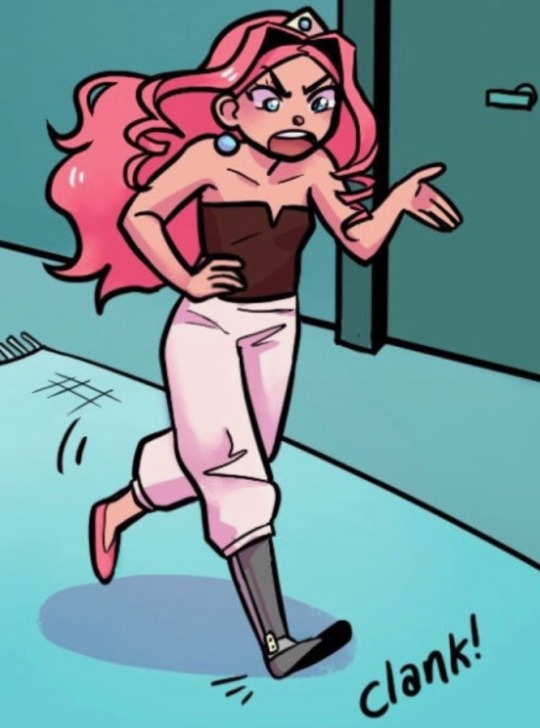

A character being totally canon LGBTQ+ and disabled was not required to be in this competition. Please check qualifications and propaganda before asking why a character is included.
Check out the other polls in this wave here.
Princess Sapphia of Mytilene-High Class Homos
Qualifications:
She is canonically lesbian and an amputee. The basis of the story is that her and her gay friend August of Phthia are fake marrying to secretly date other people (him with one of his knights and her with one of his castle's maids). She had a relationship with Marla through half of the first season, and now she's starting a relationship with Odette. In the original comic (before becoming a WebToon original), the panels never showed most characters legs so some comments did jokes about her not having legs, so in one of the last episodes before "rebooting" it to WebToon, the author momozerii decided to make this canon by showing her changing her prosthetic leg. The "reboot" shows it from the first episode (literally kicking a door open) and had a flashback scene of her using crutches and a bandage on her amputation. I don't remember if that scene showed why she lost her leg.
Propaganda:
She's so funny and cute, and I love how momozerii added her prosthetic from the start in the WebToon original version. She's really compassionate and has really good character development through the first season. There's one scene between her and Odette at the start of the story where Sapphia said some really elitist shit to her, and after apologizing she learns what Odette had to pass through as someone who didn't have the wealth and status that Sapphia has as a princess, and she actually changes, defending Odette when her old suitor, Nicolosi, pulls the same elitist shit on her.
Anything Else?:
I recommend a lot this WebToon, it has such a good story, the art is beautiful and isn't too heavy on details like other WebToon originals, the characters are amazing and complex, and it's on hiatus right now (don't worry the season finale is not a big cliffhanger, just a small hook for the second season).
Submitted by @octonine
Schnn T’gai Spock-Star Trek
Qualifications:
He is canonically dyslexic, and commonly interpreted as autistic. I do not think I have to tell you why I think he qualifies as LGBTQ+.
Propaganda:
He started it all! Spirk was the birth of slash fiction and fandom itself. Autistic, dyslexic, gay-- what can't he do?
Anything else?:
THIS APPLIES ONLY TO THE ORIGINAL SERIES VERSION OF SPOCK. NOT THE SPOCK FROM THE JJ ABRAMS MOVIES OR THE NEW ITERATION OF SPOCK FROM STRANGE NEW WORLDS. Discovery Spock does count as TOS Spock in my mind, though. AOS & SNW Spock are some of the least gay characters I have ever seen, and it is quite sad.
Submitted by @convenient-plot-device
#polls#poll#disabled characters#lgbtq characters#disability#lgbtq#lgbtq dcs round 1#lgbtq dcs wave 1#princess sapphia#high class homos#spock#star trek#star trek tos
70 notes
·
View notes
Text
This is not my typical art or meme post but a doubt surfaced in the Mcspirk Discord server about TarsusIV and if Kirk was on the list to die or to survive. So I made a kind of shallow dive in the net to see if I was able to find an answer, and I could say I did, but boy did I also find something I was absolutely NOT expecting.
For the record canon or alpha canon in Star Trek is what we see in the shows themselves.
(Some people may include here scriptwriters or directors publications/comments and interviews relating their work on the show and their intentions while making it, in general any of the key people that contributed to the canon we see in the shows. For others this is considered beta canon so it's a kind of grey area.)
Beta canon is all the rest under the Star Trek brand; novels, videogames, manuals, comics, etc.
Having established that more or less, here we go:
In alpha canon the answer to if Kirk was in the list to die or survive is; "it's tricky" xD
Memory Alpha in all accounts points to him being one of the other 4000 people that survived the mass execution, although it is not exactly specified that he was on any list to survive. There were previous scripts where Jim says he was, but it was scrapped among other things. Still, if Kodos executed the 4000 colonists all together in the antimatter chamber, and we haven't heard of any escapees or switches between people, I think it's safe to say he was on the list of survivors. However, I think it's important to note that we don't know if later Kodos just chilled, ordered more people killed or there were more deaths due to his ruling the more the situation became dire. And we also don't know how long he lasted in charge, since I couldn't find an exact time when help arrived either; it just states it arrived earlier than expected but too late to save the 4000 killed. So we can't be certain how much time elapsed from the mass execution till help finally got there.
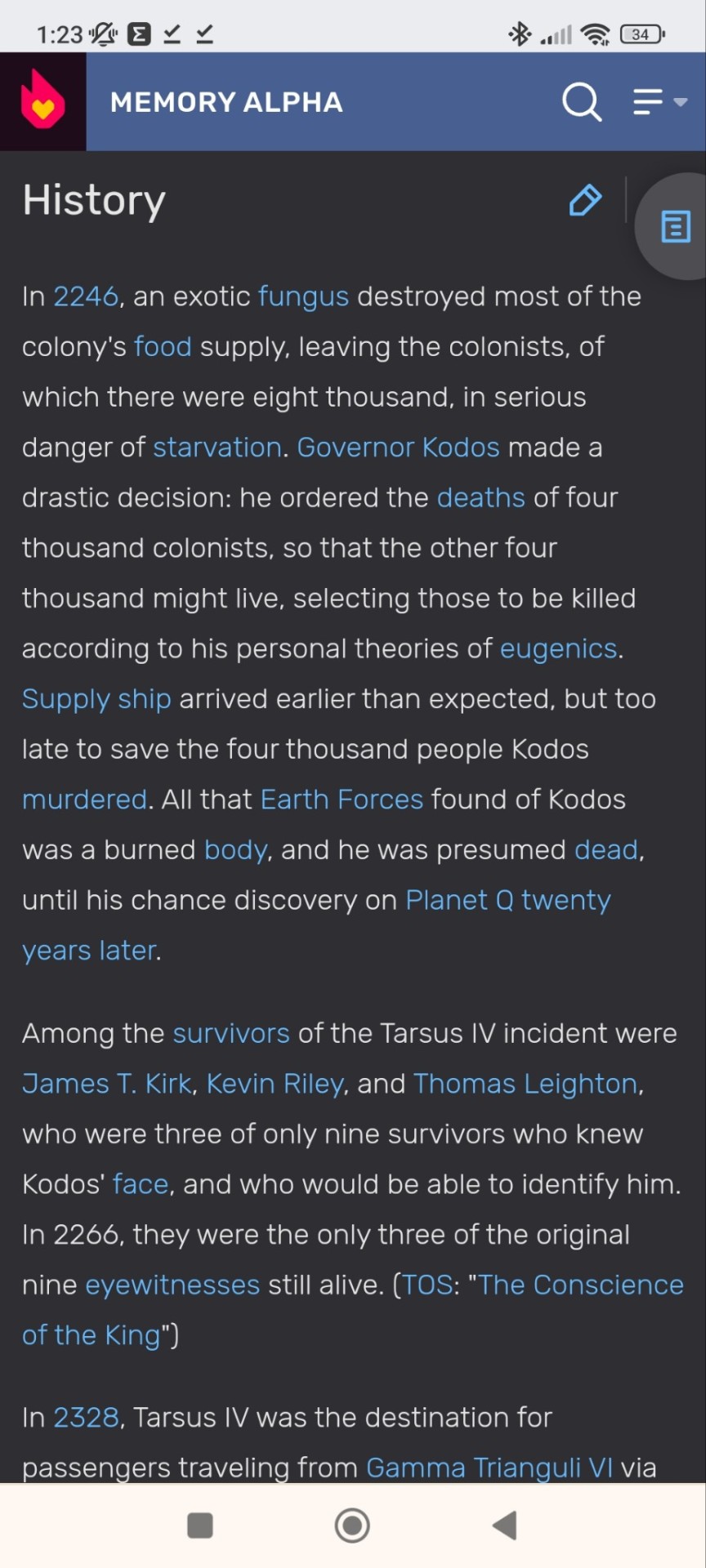
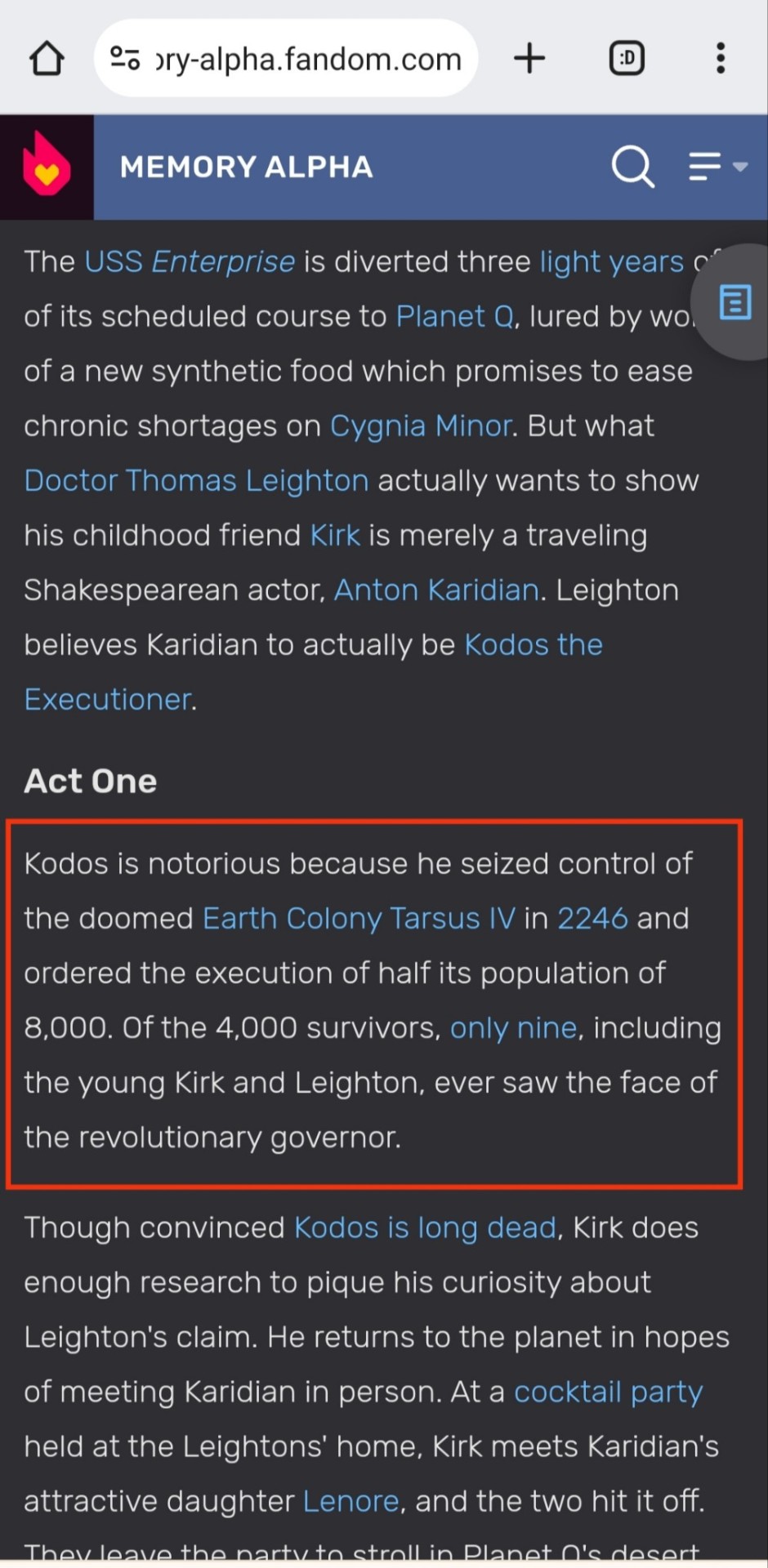


Kirk is listed as a survivor of the TarsusIV Massacre, that encompasses all the struggle since what would be the uprise of Kodos and ordering those executions, till the unknown time later when help finally arrived. But we seem to be left to wonder if he could have been sought for later executions or persued in any way. In fact when we think back at what happened to his friend Tom Leighton, who was also a survivor and one of the nine witnesses, it is understood the damage to the side of his face either was caused by Kodos himself or took place during the massacre at least, maybe caused by Kodos enforcers.
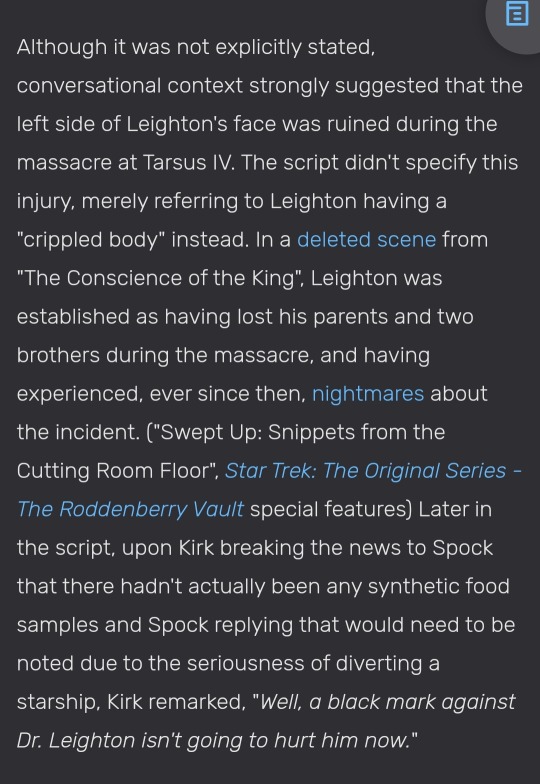
Since we don't know exactly what happened and for how long after the mass execution, we can't be sure what or who was the cause. Like most of it, it's left to interpretation. But when you get into account that him, along with Jim and Kevin Riley, who were all rather young then, are from the few people who could identify Kodos because they saw his face, added to his wounds, makes you think that at least there was some big turmoil and, be it on purpose or not, these kids ended either in Kodos presence himself when most didn't even know his face, or could retrieve that photo we see in the TOS episode from Kodos' headquarters or some other important place that may store such data. As one ST Discovery novel (beta canon) suggests and also tells us more of what transpired after the execution.
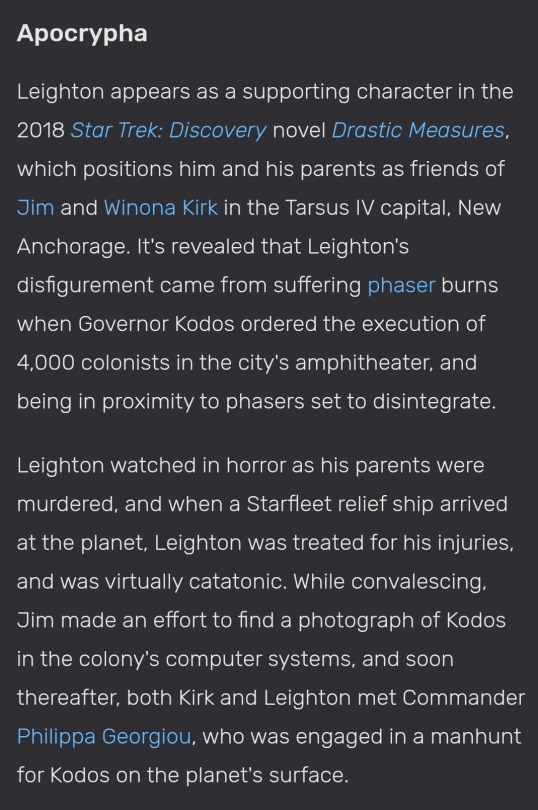
So yes, alpha canon, or "the" canon left it ambiguous on purpose, since any intent to specify was scrapped before the TOS episode Conscience of the King was produced.
But here is where it gets juicy; beta canon (specifically Memory Beta) tells a very different story, one that made me have to read the paragraph twice and fact check because wtf xD
Two novels you'll see listed in the screenshot detail that Kirk was, in fact, on the list to die, but he escaped, saving Kevin Riley while he was at it. And not only that, but that Kirk was saved by SAREK who MELDED with him to erase the memory, because he also saved KODOS and gave him his new identity (wtf Sarek? You did that because you thought it was the logical thing to do or how come?? This could have tremendous implications...)

I don't know if any of you guys knew this but I sure didn't and the fic potential for this is unimaginable xD Maybe many of those that made Tarsus fics including Spock and/or Sarek there are based on this piece of beta canon but yeah, shocking.
I'm aware that Shatner touches on more about what happened in TarsusIV in some of the ST novels he wrote, like "Star Trek: Academy #1 Collision Course" and the "Autobiography of James T Kirk". For the latter I believe I read an excerpt some time ago that talked about riots and the situation getting really violent, but I couldn't find any information in this small search and I don't have the spoons to read the book right now, so take it with a grain of salt.
In the end it is all up for interpretation and you can go either way, but you sure get some interesting details in the various levels of canon xD
#star trek#star trek tos#tarsusiv#kodos#james t kirk#jim kirk#sarek#alpha canon#beta canon#the tarsusiv massacre#shallow dive#purpleenma#star trek analysis#makes me think of what did Sarek think of Jim when he saw him again in Journey to Babel after all those years and what he did
59 notes
·
View notes
Text
Star Trek series rated by horniness (as rated by me, an asexual, so you know its objective):
Star Trek: The Original Series - what is there to say for the series that invented slashfic, fuck-or-die, and Thiess's theory of titillation in costuming? The universe is full of greased-up pecs and scantily clad women wondering what is this thing you call...love? It's easier to mention the episodes that *aren't* horny. 10/10, for how could it be otherwise?
Star Trek: The Animated Series - It's a Saturday morning cartoon series from the 70s, and yet... 3/10, for the surprising number of scantily clad muscular guys
Star Trek: The Next Generation - Oh, we *start* quite horny; Roddenberry is keen to let us know that the android has a penis in the second episode; but then Roddenberry dies, and by the final season even Troi is wearing a sensible duty uniform. 6/10 for Will Riker, though
Star Trek: Deep Space Nine - We've got Quark's, where the women are scantily clad, the holosuites are for fucking, and the waiters give themselves ear infections from doing too much oo-mox on themselves. We've got Jadzia Dax, who has three hundred years worth of sexcapades in two genders and will tell you about them at the drop of a hat. We've got Bashir and his sad blue balls for the first two seasons. We've got Klingons breaking each other's clavicles to initiate coitus. And we've got an enemy power led by the perpetual mind-melting gangbang that canonically is the Great Link. 9/10
Star Trek: Voyager - Weirdly conservative in its sexual politics. I mean, it goes out of its way to stick poor Jeri Ryan in that body condom, and there's a whole episode about space whales wanting to fuck the ship, and another one about Janeway wanting to fuck an Irishman, and *two* episodes about Pon Farr...actually, you know what? 6/10.
Star Trek: Enterprise - You know what, let me tell you about this series; this series is like a 14-year-old asexual boy boasting about his supposed sexual conquests in the hopes that it will endear him to the cool kids. It doesn't work; there's nothing genuine about it and everyone knows it; no matter how many innuendos he throws in, it's clear that there's no joy in it for him and he'd be happier if he could just go off and read comic books. Secretly, he wishes his friends still wanted to play with action figures. -1/10
Star Trek: Discovery - The show presents us with wall-to-wall gays who just...never seem to shtup each other. Like, I of all people know that sex doesn't define queerness, but...really? I guess maybe they're afraid of being less than wholesome? Anyways, 2/10 for that time that the Emperor went off to fuck a couple of Orions in the middle of a dangerous secret mission on the Klingon homeworld.
Star Trek: Picard - A series so sexless that it can't even show its main canonical couple enjoying each other's company for more than 5 seconds each season. And yet the chaste Jurati/Borg Queen pairing manages to be the hottest thing ever in the history of fiction. Anyway, I guess they technically had Agnes sleep with Rios in the first season, so 1/10.
Star Trek: Lower Decks - Oooh boy, we're at the heavy hitter now, my god. Completely, unashamedly horny. Gene Roddenberry *wishes* he could have done that orgy scene that people on Twitter were freaking out about. 11/10
Star Trek: Prodigy- They're *kids*. 0/10
Star Trek: Strange New Worlds - Not really a lot, surprisingly given their TOS pastiche. Still, we get some stuff with Spock. 3/10.
185 notes
·
View notes
Text
Between the early cancellation of Discovery, Seven/Raffi and Mariner/Jenn being erased in their respective shows, and SNW having queer coded characters but not confirming anything on screen, I'm really afraid that we're entering another "No Gays in Trek" era.
For those who don't know, 90s era star trek featured so few queer characters b/c Rick Berman largely held a policy of not wanting any homosexuality in his shows. And yes, we all remember the handful of episodes that slipped through that addressed it but the fact remains that there were no canonically queer main cast members before Into Darkness in 2016 gave us a five second shot that could be cut when whoever was showing the movie found the idea of two men in a loving relationship disgusting.
Then we got Discovery with multiple queer characters that allowed people to feel seen. And people never stopped bitching about them. The amount of times that I've had to listen to people complain that Adira's only character trait is that they're non-binary despite that literally being a single thirty second scene and never brought up again makes me understand that they very likely don't want to like the queer characters in that show. And it's not that there aren't criticisms to be made about the queer representation in Disco: Discovery Buries it's Gays before the end of the first season. Making your trans characters aliens who already have a history of gender fuckery is problematic b/c it somewhat plays into the idea that queerness is unnatural for human beings. But I never hear those complaints. Only the pronouns. Only the "We get it you're gay but don't shove it down our throats." But I don't want to get too off topic.
Now Discovery is being canceled early. And by early I mean, the writers weren't given proper notice that their show was ending. They were halfway through production and allowed to adjust the end episodes of the season to try to give a satisfying ending.
In Picard and Lower Decks, we got two sapphic relationships ("sapphic" meaning a romantic or sexual relationship between two women who aren't necessarily strictly lesbians) and they were pretty good. People had been asking for Seven to be queer and Jeri Ryan had been playing her as such since her introduction (see again: Rick Berman) and to see her finally get to express that was really healing. Mariner got off to rocky feet when the creators tried to pull a "Dumbledore is gay" where they said she was bi but didn't commit to it, but they she actually got a fairly satisfying relationship in season 3.
But in their most recent seasons, both were completely written out. Seven/Raffi gave us no explanation beyond that they "broke up." They went out of their way to keep them from being on screen together for most of the season. Mattis said in a Reddit AMA that he wanted Seven to be captain and Raffi to be first officer at the end of the season and that Starfleet would have regulations against relationships between the two despite the biggest reason Seven was promoted to captain was that she was a rule breaker. We didn't even get that much for Mariner/Jennifer. Jenn just wasn't in this season except for two background appearances.
And in Strange New Worlds there's just… nothing. SNW is the most recent new show and there's no queer representation. They code Ortegas as gay but don't actually confirm it on screen. There's just… nothing.
And this is how you loose the culture war. The bigots make enough noise that the show that is supposed to be a beacon of diversity doesn't necessarily side with them but they just kinda bow out of the conversation. They decide that it's easier to not bother than to take a stand. And so I and many many queer star trek fans are left wondering:
Does the franchise even want us any more?
88 notes
·
View notes
Text
Star Wars fans: What do you think of the TOTE trailer?
Me, also a Trekkie: The first two episodes of Star Trek: Discovery's finale season just aired, who CARES about the newest Star Wars show I'm going to boycott??
#star wars#star trek#star trek discovery#anti tote#i literally could not care less about the ugly animated show about evil people when i get to stare at michael burnham for an hour every wee#if anyone who follows me is watching star trek discovery pls talk me about that!
32 notes
·
View notes
Text
I listened to the All Access Trek Podcast. Laurie Ulster said something that piqued my curiosity. Laurie mentioned that the writers of season 5 of Discovery want to be more connected to the larger Trek universe.
Then, Laurie and Anthony Pascal noted how different this attitude was from the early seasons of Discovery. Both Laurie and Anthony were involved in and around Trek productions, and Laurie herself was a host of After Trek (back when it existed).
Laurie mentioned that in season 1 of Discovery, studio executives would freak out if other Trek properties (specifically 90s Trek) were mentioned or alluded to. The TOS era is allowed, but it seems anything related to 90s-era Trek was not allowed.
And, it’s all because Star Trek Nemesis flopped big time.
(According to Jonathan Frakes he was told that Nemesis was the one that actually lost money.)
The effects of Star Trek Nemesis’s flop were so wide-ranging it almost killed the franchise. A few years later, they canceled Enterprise and any upcoming Trek live-action projects.
Nemesis is to blame for why neither Deep Space Nine nor Voyager had a live-action movie.
According to BTS reports and what the TNG actors have mentioned, Nemesis was a troubled production from the start. It got worse when the director, Stuart Baird, didn’t even care to know the actors’ names (famously mispronouncing LeVar Burton’s name). Additionally, he never bothered to watch a single episode of TNG. Marina Sirtis and LeVar Burton have been outspoken about how much they dislike Nemesis and the director (more from Marina on this).
(Both Marina and Gates McFadden weren’t fond of the other TNG era movies either, especially Gates because she was little more than a cameo in the movies.)
After Nemesis flopped it took years for Star Trek to return, and after that, there seemed to be a mandate from the studio to never mention 90s Trek.
This is why Star Trek: Picard was such a big deal, especially since it directly references events from Nemesis.
(And, an even bigger deal for Picard Season 3 reunion getting produced.)
The Nemesis effect continues to have an impact on the movie side of the franchise. The majority of announced projects take place in the pre-TOS era, TOS era, or the Kelvin timeline but there are no projects set during or after the 90s-era Trek.
This is why mentioning a ship class called Janeway was big but even bigger, showing Picard and directly referencing to the Dominion War and Deep Space Nine and Discovery is a big deal.
Anyway, I just wanted to mention all this because it baffled me why the executives were so into TOS-era trek and there seemed to be no interest for 90s-era Trek. And, learning about all this finally answered all my questions.
TLDR, I like TOS era but I’m not into the TOS-era and I enjoy the Kelvin timeline as much as anyone else but it is not the era of Trek I’m interested in. So the movies set all TOS or Pre-TOS era— its just not something I’m going to jump around about.
20 notes
·
View notes
Text
An essay I wrote for school on Strange New Worlds' problems with ableism, complete with bibliography:
Star Trek: Strange New Worlds has numerous problems, from its retooling of the Gorn into knockoff xenomorphs to its erasure of Spock’s Jewish roots to its overreliance on nostalgia, but its most glaring flaw is its painful undercurrent of ableism. The conflation of disability with death, the ignorance and tacit pardoning of eugenics, and the disposal of multiple disabled characters come together to weave a harmful and ignorant pattern in the show’s writing.
Christopher Pike’s character in Strange New Worlds is defined by disability. The dilemma he wrestles with in almost every episode is the looming specter of his future disability, which was revealed to him via time crystal in season two of Star Trek: Discovery. In the twelfth episode of season two, “Through The Valley of Shadows”, Pike must harvest a time crystal in order to send the life’s story of a dead alien to the future to protect it from an evil artificial intelligence intent on destroying all life in the galaxy. When Pike touches the crystal, he sees visions of his future, in which he is caught in a deadly radioactive explosion and left with severe burns and full body paralysis, able to move and communicate only through a specialized wheelchair. “The sequence ends with a final linked pair of nightmarish shots, a centred close-up of the older Pike’s face beginning to melt as he screams matched with the younger Pike’s own horrified scream as he falls backward into the present moment,” (Muredda, Angelo). As Muredda says later in the same article, this portrayal imagines disability as “a terminal point, something to scream about in terror, and the embodied sign of no liveable future at all.” The depiction of disability as a horrifying fate, and of the disabled body as an object of disgust and/or fear has a long history in the genres of horror and science fiction; previous and current Star Trek series are not immune to this. The Borg Queen, who appeared most recently in Picard, is missing most of her lower body and uses a robotic replacement to walk— her prosthetic spine is used as an object of horror and disgust when she first appears in First Contact (1996).
While Strange New Worlds had the opportunity to break this pattern and defy ableist stereotypes with Pike, they chose instead to follow the path Discovery had laid for them. Despite the fact that it is made very clear that Pike will be disabled, not killed, by the explosion he will be caught in in the future, every character within the narrative speaks of Pike’s fate as if he is going to die. Pike says, less than twenty minutes into the pilot: “I know how and when my life will end.” This writing decision mirrors the real-life belief that disabled peoples’ lives are akin to “a fate worse than death” or “not worth living,” a sentiment which has led to real deaths: “. . . [early in the pandemic] this belief — that we’re just surviving, not living, and thus have limited quality of life — lead to forced DNRs being put in the files of disabled people in the UK and lead directly to the death of a disabled man, Michael Hickson,” (Lloyd, Kelas). Hickson was denied treatment for pneumonia in Austin, Texas due to his doctor’s perception that he “didn’t have much of a quality of life.” He was put in hospice against his family’s wishes and died at the age of 46. (Shapiro, Joseph). For Strange New Worlds to equate Pike’s disability to the end of his life is irresponsible and reinforces the cultural biases that led to the death of Hickson and continue to impact the quality of treatment disabled people receive the world over.
Christopher Pike’s initial appearance in the original series episode “The Menagerie” was actually very progressive for the time; despite the limited communication of the blinking-light system in his wheelchair and his ending being living out the last of his life in a virtual reality where he could walk again, he was still a disabled person on television in a position of power.
When Pike first appeared, the Ugly Laws were still in place in much of the United States. Someone visibly disfigured/disabled was not to be seen in public spaces, at the risk of fines or jail . . . Captain Pike’s appearance in The Original Series was revolutionary. Here was not just a visibly disabled person, but they were someone Spock respected and cared about enough to risk his career for. [Disabled people] didn’t have a great existence, but they had one, and Pike was still valued as a person. (Lloyd, Kelas).
It would have been quite easy for the writers to modernize Pike’s portrayal to further disability representation in the way Pike first did: @hard-times-paramore has written an alternate ending (a mixed media series titled “The Captain’s Chair”) for Strange New Worlds in which Pike goes on to captain a new starship after becoming disabled, assisted by an interpreter, a caretaker, and futuristic medical technology. This alternate ending carries the message that disabled people are still people, who can and should be allowed a place in science fiction, as opposed to the current message sent by SNW, which is that significant disability is akin to a death sentence, even in a fantastical future.
However, there is more to Strange New Worlds’ portrayal of disability than just Captain Pike. The show is also very preoccupied with genetic augmentation and the Federation’s attitude toward it. While this is far from unique among Star Trek media, unlike other Trek properties which have covered this topic (Doctor Bashir, I Presume?, Chrysalis, Space Seed, Affliction/Divergence, etc) Strange New Worlds does not acknowledge the real-life equivalent to science fiction genetic augmentation: eugenics. SNW portrays genetic augmentation as a neutral practice targeted unjustly by the Federation because of outdated prejudices, with no examination of what genetic augmentation is a stand-in for. While the original series (in “Space Seed”) first introduced the Federation’s ban on genetic augmentation as a justified protective measure against the breeding of warlike “superior ambition” among men of “superior ability,” Strange New Worlds portrays genetic augmentation as an unjustly discriminated-against trait whose origin and consequences mean little to nothing.
Strange New Worlds’ main conduit for their genetic augmentation plotlines is Una Chin-Riley, the first officer of the Enterprise. She is a member of an alien species called Illyrians, who genetically modify themselves to suit the environments of planets they colonize. She herself was genetically modified as a baby, and is thus legally barred from joining Starfleet— however, she lied on her application to Starfleet Academy to get in. The plots revolving around her concern her arrest for violating Federation law and the subsequent trial, which is used as an extended metaphor for discrimination against, and the fight for civil rights for, marginalized groups. “Ad Astra Per Aspera,” the episode covering Una’s trial, is intentionally vague with its metaphor, to the point that just about any marginalized group could be represented by it. This episode is, on its face, fine. It argues against discrimination through allegory quite adeptly, discussing the concept of “passing” as part of a non-oppressed group and broaching the topic of systemic oppression. However, it has one glaring flaw in its base: the stand-in it chose for real-life oppression. Genetic modification, unlike other fantastical attributes that can be used to metaphorize oppression, has a bloody real-life history involving the deaths and sterilizations of millions of people. Strange New Worlds, however, appears ignorant of this fact: not once does the topic of eugenics come up in any of their episodes about genetic augmentation. Not once does the topic of disability come up, either. This is either an unwillingness to engage with the realities of what those who seek to change humanity’s genes have done and continue to do, a grave oversight, or mere ignorance. Whichever one it is, this omission of eugenics from the narrative of genetic augmentation is one that cannot be ignored. Its omission reads as a tacit endorsement of genetic augmentation at times, such as when Una and La’An say, in “Ghosts of Illyria”:
LA’AN: All my life I've hated augments. Hated what people thought of me because I was related to them. Understanding why they were outlawed in the Federation. The damage they did. They almost destroyed Earth.
UNA: [. . .] My people were never motivated by domination. Illyrians seek collaboration with nature. By bioengineering our bodies, we adapt to naturally-existing habitats. Instead of terraforming planets, we modify ourselves. And there's nothing wrong with that.
By ignoring the part eugenics plays in Star Trek’s portrayal of augmentation, and instead portraying the issue as a matter of prejudice based off of the fictional event of the Eugenics Wars— when augmented “supermen” became dictators and killed millions in conquest and war— Strange New Worlds completely fails to examine the real-life implications of their metaphor.
What makes this episode’s flaws worse is that another Star Trek series already portrayed the potential expulsion of a genetically augmented person from Starfleet, handling it with better understanding of the eugenic undertones of genetic augmentation, and it did so in 1997. In the season five episode of Deep Space Nine, “Doctor Bashir, I Presume?”, it is revealed that Julian Bashir, chief medical officer of Deep Space Nine, was illegally genetically modified by his parents as a small child and is in danger of being thrown out of Starfleet because of this revelation. Throughout the course of the episode, the audience learns that Bashir’s parents chose to modify him because he was intellectually disabled as a child. His mother believed that his life would be better if he were “normal,” while his father wanted a successful son and believed that intellectual disability was inimical to that end. The episode expresses, through Julian’s anger at his parents, that modifying a person to rid them of perceived “undesirable traits” is wrong, but that it is also wrong to unilaterally bar people from Starfleet based on a decision that was made for them by eugenicist parents. This message is far more clear than “Ad Astra Per Aspera”’s, especially on the subject of disability and eugenics. Strange New Worlds’ complete neutrality on and/or tacit approval of genetic augmentation/eugenics, in contrast to Deep Space Nine’s nuanced examination of the topic, is glaring.
The specific problem with Strange New Worlds’ neutrality on genetic modification is that for a species to be changed on a genetic level for any reason, traits must be eliminated. In a science fiction setting, this can be accomplished by simply changing the genetic structure of a consenting adult with a futuristic medical tool, rather than through violence as in our reality, but this, too, presents ethical problems. What is considered a problem to be cured? Who makes that decision? What happens to those who don’t want something modified out of them? What happens to any children they may have? Who gets to have control over technology with the power to eliminate or introduce genetic traits at will? What place do disabled people have in a society built off of achieving peak physical performance in a given environment? Strange New Worlds attempts to answer none of these questions. It acknowledges none of them. And this silence leaves disabled people out of the conversation completely by not even considering them. Today, in Denmark and Iceland, almost 100% of fetuses with Down Syndrome are aborted; the law in Iceland even specifically states that abortion is permitted after 16 weeks only if the fetus has a “deformity,” which Down Syndrome is specified to count as. (Quinones, Julian; Lajka, Arijeta). An entire anti-vaccine movement was begun in Britain because parents were so afraid of having a child with autism and chronic digestive disease, a child like me, that they risked their children dying of measles. This is what real-life genetic engineering looks like, and Strange New Worlds has failed to acknowledge that. I, at least, consider that a failure of writing, empathy, and allyship.
Strange New Worlds’ portrayal of disability is not relegated to Pike’s fate and Una’s augmentation, however. The show has several other characters who either are disabled or become disabled at one point. Rukiya, Dr. M’Benga’s daughter, is treated less as a character and more as an object for the emotional development of her father, a position many young disabled girls occupy in fiction. “[This story] centers Dr. M’Benga, and his pain, and his struggle, and doesn’t grapple with what Rukiya’s going through.” (Lloyd, Kelas). Rukiya has an untreatable terminal cancer, and is kept in a state of suspension in the transporter buffer by her father while he searches for a cure. Her story ends when the Enterprise enters a sentient telepathic nebula with the power to warp reality, and it offers to keep Rukiya within itself so that her disease will not progress and she will be able to grow up. M’Benga decides that this is the best option, and so relinquishes Rukiya to the nebula. She is never seen again. “She is disabled, and then she’s removed . . . The disabled person was put into [a] box and left behind, like so many disabled people have been put away in care homes and institutions and left behind.” (Lloyd, Kelas). Jax agreed, saying: “It just felt like she was poofed away for convenience. Like, ‘There! The problem is gone! The terminal illness or the girl? Both! Don’t worry about it!’”
The only other disabled main character on SNW is Hemmer, who is a member of a blind species called the Aenar. “While the Aenar cannot see, they believe that their telepathy gives them a ‘superior’ awareness of their surroundings compared to sighted people (Vrvilo, 2022). Because of this, the Aenar are highly criticized by the disability community as falling into the ‘magically disabled’ trope.” (Harris, Heather Rose). Bruce Horak, the actor who plays Hemmer, is blind himself, which is a genuinely good decision in terms of representation and support for the disabled community. However, Hemmer dies in the penultimate episode of season one. This decision was not received well by disabled fans: “It just kind of felt like a kick in the teeth. I finally found some good disability representation played by a disabled actor [who] isn’t a one off character, and they die in the first season.” (Jax). Both Hemmer and Rukiya are left behind by the narrative of Strange New Worlds, and with them, so too are disabled perspectives. The crew of the Enterprise is now entirely able-bodied, and the only remaining character whose story directly concerns disability is Pike, who repeatedly asserts that his life will end once he becomes disabled. This state of affairs is the embodiment of being spoken for, and being spoken over.
There is a saying in the disabled community: “Nothing about us without us.” This saying means that abled people should not attempt to help, treat, or speak about disabled people without involving disabled people in their efforts. Disabled people are often denied autonomy over their bodies, medical care, relationships, and lives; to deny them a part in operations meant to help them is to further deny them dignity and respect. This is what Strange New Worlds is doing by writing disabled stories with no disabled writers in the room— while they did well by casting Bruce Horak to play Hemmer, it is not enough to have disabled people in front of the camera. They must also play a part in writing, directing, planning, and all other work behind the scenes if Strange New Worlds wishes to tell their stories. In order for Strange New Worlds to rectify their pattern of ableism, they must listen to disabled voices.
BIBLIOGRAPHY:
#star trek#star trek: strange new worlds#star trek snw#snw#strange new worlds#ableism#media analysis#disability#snw critical#this one is my tag
33 notes
·
View notes
Text
Thoughts on the State of Trek
I would be less upset about Discovery ending if they had known going into season 5 that it would be their last. But that was not the case. The additional filming to give it an actual finale is good and I have no doubt that it will be as good a finale as they can do under the circumstances.
But recently I’ve been more observant of Trek fans online and there is a thing happening where I’ve seen far more immediate praise of Strange New Worlds and the current/final season of Picard than any other new Trek show has gotten.
Strange New Worlds is a good show! It is also specifically emulating the original series and has a straight white male captain as the lead. (yes, Pike rocks, that is not the point here)
The current/final season of Picard (which I do think is good!) has radically altered the tone of the show into a revival/sendoff for The Next Generation, as well as emulating and referencing Star Trek media of the ‘80s and ‘90s. And again, straight white male lead.
Both shows, particularly this season of Picard, have been pretty immediately praised by certain types of Trek viewers. Specifically longtime straight white male fans.
I’ve also noticed less diversity behind the camera of Strange New Worlds and Picard compared to Discovery. At least if one watches all the behind-the-scenes stuff for those shows (which I’ve been doing a lot lately). There’s not zero diversity, but Picard especially has been putting more emphasis on bringing back legacy crew members who are majorly, you guessed it, straight white males.
Contrasting that with how Discovery was met with skepticism from the get-go and is openly dismissed by certain older fans (one I talked to at work said something like “I guess I don’t get it because I’m not a millennial.”) makes me a bit angry because a lot of these same longtime fans watched and stuck through the first two seasons of The Next Generation. Those two seasons are some of the roughest television I’ve ever seen, and the handful of good episodes hidden throughout do not make up for it. But fans at the time stuck through those seasons anyway.
Why didn’t Discovery get the same treatment from those vocal longtime folks?
Why did The Next Generation, which is a very different type of show compared to the original series, ultimately become a beloved show? I’d like to believe it’s because people accepted the show for what it was once it found its footing.
But when I see comments like “Picard season 3 is the best Trek in 25 years”, I get mad. You gave Picard, a show that has two seasons with a mixed reception at best, a continued benefit of the doubt because of nostalgia for an older show, and because this season is essentially a Next Generation reunion. But you dismissed Discovery because it wasn’t “your” Star Trek show.
Literally part of the purpose of Star Trek is infinite diversity in infinite combinations. Discovery not only gave us an incredible lead character played by a Black woman, it gave us representation across the entire cast of both people of color and queer folks. As a nonbinary person, Adira’s quiet coming out scene had a profound impact on me, and later served as a helpful reference point for coming out as NB to my dad, who watches and enjoys Discovery.
Discovery spends an entire season depicting a debate between multiple characters/factions about how to handle a situation that threatens all Federation members. It does so with empathy for all points of view, and ultimately resolves this threat not with an action sequence, but a conversation. That season of Discovery (season 4) is Star Trek as fuck, and some of the best Trek ever.
Hell, Star Trek Beyond is so good that it manages to take the flashy action J.J. Abrams approach to Star Trek (which I have mixed feelings about because Trek ’09 is fun and despite his storytelling problems, Abrams is by all accounts a genuinely nice person so I won’t be shit-talking him here) and make it more properly Trek by introducing a villain who believes conflict is necessary for human evolution, which is the antithesis to Roddenberry’s whole vision for Trek of being a future where we work to resolve and avoid conflict rather than seek it.
Strange New Worlds and Picard (seasons 1 and, so far, 3) are both good and also contain great Trek. But they are also fundamentally more appealing to the nostalgia of middle-aged straight white male fans. And they are the shows that are getting more visible attention and praise.
Lower Decks is awesome and has a fantastic Black female lead in Tawny Newsome. But it meant something to have Sonequa Martin-Green and Newsome be the leads of two Star Trek shows airing at the same time.
And it means something for the live-action show with a Black woman as the lead to be cancelled while the animated show with a Black woman as the lead but a straight white male as the head writer is allowed to continue.
I don’t want Star Trek to become like Star Wars and turn into an endless cycle of fan service. Star Trek has had a huge impact on our planet over the 55+ years of its existence. Don’t make the mistake of turning it into another franchise that exists as a way for whiny white dudes to center themselves over the global majority.
(PS, Paramount, how the hell have you dragged your heels over Michelle Yeoh’s spinoff for this long? She has an Oscar now, what the hell is your excuse?)
#star trek#rant#star trek: discovery#star trek discovery#star trek: picard#star trek picard#star trek: strange new worlds#star trek strange new worlds#star trek: lower decks#star trek lower decks#star trek: the next generation#star trek the next generation#yeah I'm mad about a lot of stuff going on in the world but this is the only thing I felt knowledgeable enough to comment on
170 notes
·
View notes
Text

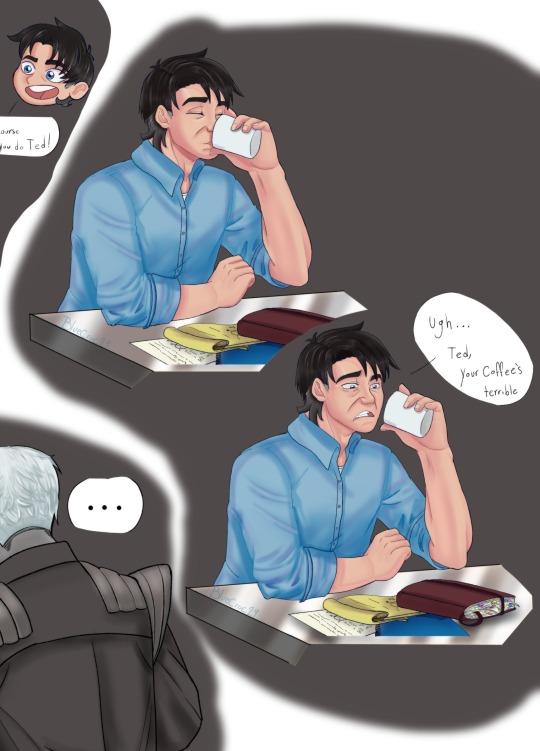
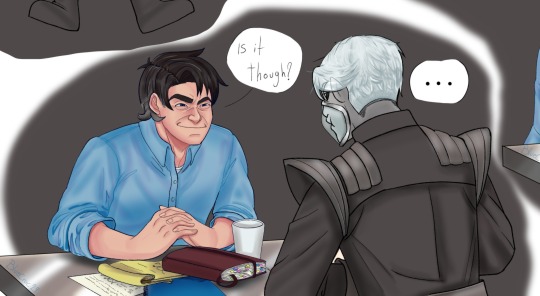

Doodling while listening to the episode turn into wanting to color it. "Admit it ted" (Season 2, episode 2) Of Midnight Burger. If I have to choose(I love all of the episodes)got to be my favorite episode.
I'll admit, I'm not good with character design and because of that, I couldn't give a better design for "Ted". I went with designing him based on the common depiction from Alien abduction stories of them being (little) grey. I'm sure he's more alien looking instead of almost human but I lack imagination. Even though I'm an artist, ;n ; His Uniform based on the combination of the space force uniform, Star trek Discovery, and Starlord. Also, I first thought that Ted wore some kind of face mask or something because his VA's mic sounded like it has an an effect on it while he spoke until they were casted in another role. I want to imagine they wear masks because, idk, they are sensitive to different atmospheres much like Bertbert was when she went to Earth. Also, I'm even worse as a prop designer. Maybe not a final design, or would he be better in green instead of grey?
I imagined Caspar's facial expression mirrored the Thor 'is it though' meme when he questioned Ted after the big explosion. I couldn't get the imagine out of my mind and had to doodle it. Also imagined him having hair growing long the longer he stayed in the diner. He may not aged but It's been a long time since he's seen a barber. Also graying but I'm sure he was already graying way before he was unintentionally abducted. I had another design for Caspar, the only difference is the hair, which looked awful, like he tried to give himself a haircut and didn't work out while Zebulon and Elfie tried to assure him that it doesn't look as bad as he though but they have to pray to god for forgiveness for lying and laughing.
Maybe I'll do a lil doodle of Leif putting a Caspar's lil hair in a pony tail. He'll be happy that they'll be pony tail buddies!
If I do more doodles, I think I'll just stick with the miniature like in the first slide because it just look better and easier for me.
59 notes
·
View notes
Text
Who doesn't love a good Shuttlebay?
Almost always bigger on the inside, they fit whatever the plot needs💕

Here's where it all started, the U.S.S. Enterprise NCC-1701 from the OG Star Trek series.
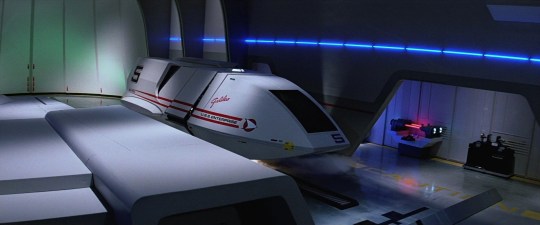
Here's the 1701-A from Star Trek V: The Final Frontier. Insanely enough, the set was originally the palace from Coming to America. This is the only time a full size shuttlebay has been a practical set.

The Next Gen Enterprise-D had an enormous main shuttlebay designed. Enormous and majestic and WAY too expensive to depict, so we only ever saw little secondary bays in the neck of the ship like this one. The set was also used as every cargo bay ever needed.

U.S.S. Defiant NX-74205
This shuttlebay is extra magical, since it didn't exist until it was suddenly needed for an episode. As you can see, it went from a having a protruding tractor beam emitter to a recessed set of doors in the space of a few episodes.

U.S.S. Voyager NCC-74656
This shuttlebay never looked the same twice and changed size to fit whatever was needed at the time. Here it barely fits the Delta Flyer but at other times it holds the Delta Flyer and other ships with room to spare and somehow one time Neelix's ship (not shuttle, ship!) was revealed to just be sitting in storage since the pilot episode
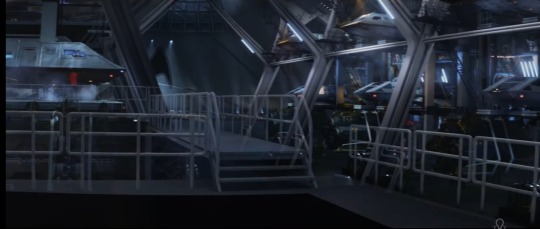
U.S.S. Enterprise NCC-1701 (AOS)
The Kelvin Timeline movie Enterprise featured the King of shuttlebays. Requiring a massive size cheat to fit inside (this Enterprise is supposed to be 725 meters long, but to fit the shuttlebay it needs to be 1200 meters), it features more than a dozen shuttles in racks along the walls. Tons of high up walkways for crew to fall from and enourmous support beams that are seemingly designed to make landing as hazardous as possible

The U.S.S. Discovery NCC-1031 has an enourmous shuttlebay, and the doors get jammed open after the first season so we always get to see inside.
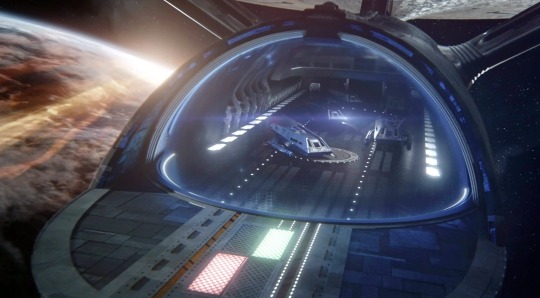
U.S.S. Enterprise NCC-1701 (SNW)
Nice and roomy, but not roomy enough for the hundred or so drones they launched at the end of Discovery season 2
#star trek#star trek discovery#star trek aos#star trek the original series#tng#ds9#starship design#shuttlebay
226 notes
·
View notes
Text
I was thinking that while Discovery has undoubtedly changed throughout the seasons (some ways long overdue, because if your idea of being "edgy" is just being racist then you get season 1), ultimately it's always been just like itself, very fond of big plots and big speeches, enamored with unnatural dialogue (in early seasons because the writers thought they were being so clever, in later ones because the show is deliberately dumbing its writing down), plagued by poor pacing, and the hopeful message that every season wanted to convey not entirely supported by what actually happens in the story.
In the latter respects season 4 did better than previous seasons, and again I certainly don't want to return to the season 1 approach, but my reluctance to watch season 4 wasn't entirely unfounded, either. I said this before but I'm in the 'generation' of Trekkies whose point of entry to the franchise was Discovery, back when it was a new show on Netflix, and it's always been... so viscerally disappointing to watch it constantly fall short of the potential these characters were offering. Season 4 did not exactly change my mind. If anything the handful of good episodes (which were very good!) made me long even more for the ideal version of this show that I could glimpse in there, and which I could wholeheartedly support and recommend without any caveats.
And I mean, this is not just on Discovery either. All the other live-action shows suffer from the same problems I outlined above, and SNW and Picard staunchly refuse(d) to confront their "edgy" racism issue while also being mediocre TV, so Discovery is still miles ahead of them. I also don't think the more structural writing problems should come as a surprise post-WGA/SAG strike. All these shows have been made on pretty strict budgets, by cutting corners wherever and whenever the production could (eg moving to Canada). I'm assuming the labor practices in the writing room and on set were along the lines of "squeeze these people for all they got as fast as you can, one season at a time" since 2016, and that is not a recipe for thoughtful, or even just sensical, television. (Plus, Discovery has had a history of workplace harassment in the writing room since basically its inception, and that can't have helped. That is hopefully something the show has left behind since season 3.)
So I suppose Discovery will keep Discovery-ing in the next, final season. The plot will be universe-ending, there will be speeches every episode, the dialogue will make you wonder how do these people even live huddled all together without going crazy—if Star Trek is overall an allegory about the workplace, then Discovery now reflects the recent corporate tendency to deflect actual grievances through the use of therapy language and the idea that everyone should be always 100% open about their struggles with everyone else, no matter how appropriate for the situation it is. That sums up my expectations pretty well, I think.
After all these years, I'm unmoved by Discovery's promise of a future where every big problem can be solved if you say the right words, with the right attitude. Contrary to its purported message, the show proved over and over that that isn't even enough to make a scifi show I could find consistently entertaining. But I will still be there to watch season 5, if anything because sometimes I like to see things to their end, and I'm still irrationally fond of this mess and these characters. Perhaps I'll have a good time along the way as well.
31 notes
·
View notes
Text
Handshakes as rebellion: Star Trek Discovery thoughts
So I’m watching Star Trek: Discovery (finally) and I just watched the episode where Sarek nearly dies and keeps going back to the moment Michael was supposed to be admitted to Vulcan Science Academy, and at the end she’s pushing to be more human and reintroduces herself to Ash Tyler with a handshake and a smile. Up until this point she’s been very no to handshakes cause Vulcan raised, and while it’s not logical, it is fun to imagine what her hand thought process is.
Star Trek loves to back track the Vulcan hand shit they built in, ya know to make Spock and Kirk less in love, but it’s there and Michael’s whole resistance/aversion to handshakes is so stark. Like you could argue she grew up with touch telepaths so it’s just polite to not touch hands, but touching hands is also an intimate thing (See Vulcan kisses) for Vulcans, that the mind tends to wander.
After learning her Dad (fuck you Sarek, blood or not, that’s your daughter you fuck ass) basically did a big betrayal, and then nearly let himself die rather than show her, AND LET HER THINK FOR YEARS THAT SHE LET HIM DOWN, one of the first things she does (after giving Sarek what I like to call, the oldest daughter shake down), is go talk to the new cute boy and offer to shake his hand again with a smile.
If we’re talking text that was definitely a rebellion for Michael. She’s shed some of her Vulcan conditioning because it doesn’t serve her healing process, she realizes now that her and Sarek were never going to live up to what the other wanted from them, and she’s embracing her humanity.
But if we’re just little gremlins for a second it looks like Michael went up to a cute boy and asked to make out after her dad almost died.
It’s fun to imagine, in a cracky sense, Michael holding hands with boys in her teens and Sarek finding out and giving lectures about propriety and shit. Amanda walks in from picking up Spock from school and the vibes are tense, Spock immediately knows whats up because he’s the one whose been keeping look out for Michael (idk if that’s accurate to them yet but I hope it is) when she sneaks off and meets with idk Salvir, the neighbors son who she really thinks is boring but has nice hands.
Amanda hears what the problem is tries not to laugh but truly thinks this is dumb, and can’t help but be brought back to her own dad chiding her about going around with that Vulcan boy (they were full grown adults, but still) and how it looks unseemly. And she says as much and Sarek goes green, and Michael and Spock are watching and he drops it. Michael doesn’t hold hands with Salvir anymore…she holds hands with Chu’lak, who lives two roads over and studies at home so Sarek never finds out.
#is this something?#idk#I haven’t seen enough to fully understand the dynamics#star trek#star trek discovery#michael burnham#s'chn t'gai sarek#spock#amanda grayson#family drama#family dynamics#vulcan culture#holding hands on Vulcan is basically making out#don’t even think about threading your fingers together#don’t even imagine running your thumb over the knuckles that’s what loose girls do#star trek disco spoilers
18 notes
·
View notes